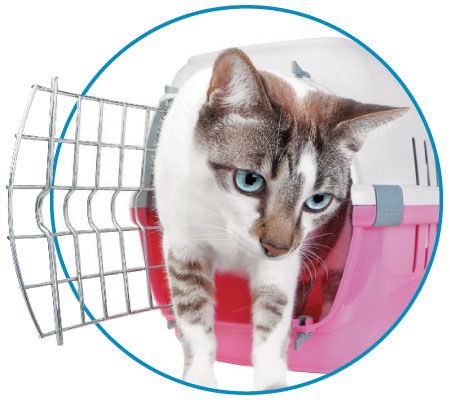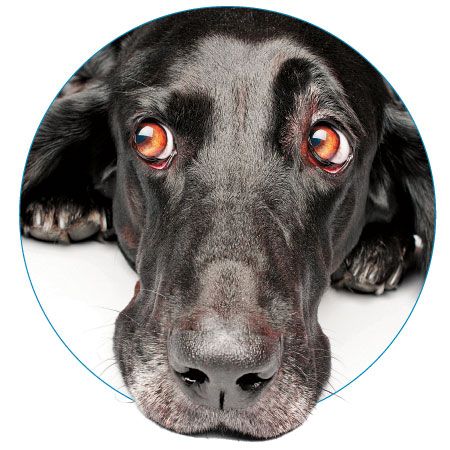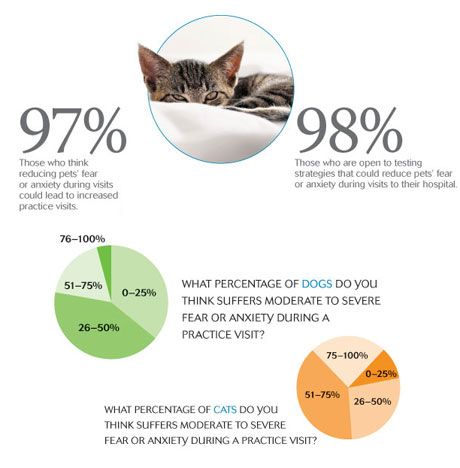Keep calm and Fear Free on
We found that a softer, gentler veterinary experience is gaining traction. Are you on board?

Explore the breakdown of data gleaned from 750 veterinarians who participated in the dvm360 survey Veterinarians' Attitudes About Fear Free Practice, Advanstar Veterinary, October 2013. Overall, results show most vet- erinarians are familiar with Fear Free practices, but aren't necessarily implementing them. However, nearly all agree that decreasing fear could increase visits.
Recommend crate/carrier training to clients
69% Regularly do this now
27% Sometimes do this
3.5% Could do this but don't now
1% Seems too difficult
0% Not interested
Proactively offer pharmaceuticals or supplements for relaxing pets before visits clients
17% Regularly do this now
55% Sometimes do this
22% Could do this but don't now
3% Seems too difficult
4% Not interested
Use species-specific pheromones in your facility
34% Regularly do this now
29% Sometimes do this
30% Could do this but don't now
3% Seems too difficult
4% Not interested
Use species-specific pheromones on your clothing
11% Regularly do this now
16% Sometimes do this
61% Could do this but don't now
4% Seems too difficult
8% Not interested

Request clients bring pets in hungry (if not medically contraindicated) so they readily accept treats
6% Regularly do this now
13% Sometimes do this
63% Could do this but don't now
6% Seems too difficult
12% Not interested
Offer pets treats almost continually during visits (if not medically contraindicated
33% Regularly do this now
36% Sometimes do this
22% Could do this but don't now
3% Seems too difficult
6% Not interested
Separate cats and dogs in the waiting area
29% Regularly do this now
19% Sometimes do this
21% Could do this but don't now
28% Seems too difficult
4% Not interested
Offer clients with cats a cover for their carriers
11% Regularly do this now
20% Sometimes do this
61% Could do this but don't now
4% Seems too difficult
4% Not interested

Recommend that clients with cats not set carriers on the floor in the waiting area
14% Regularly do this now
20% Sometimes do this
58% Could do this but don't now
5% Seems too difficult 4% Not interested
4% Not interested
Give cats time to acclimate in the exam roomtraining to clients
30% Regularly do this now
46% Sometimes do this
19% Could do this but don't now
3% Seems too difficult
2% Not interested
Let dogs approach the doctor or team members rather than approaching them
57% Regularly do this now
35% Sometimes do this
6% Could do this but don't now
1% Seems too difficult
1% Not interested
Conduct exams on the floor or examine smaller pets in your lap
48% Regularly do this now
38% Sometimes do this
7% Could do this but don't now
3% Seems too difficult
4% Not interested

Take specific steps to reduce noise in the practice
41% Regularly do this now
31% Sometimes do this
20% Could do this but don't now
6% Seems too difficult
1% Not interested
Use pet massage before or during exams
15% Regularly do this now
26% Sometimes do this
37% Could do this but don't now
11% Seems too difficult
12% Not interested
Play music composed for pets
4% Regularly do this now
5% Sometimes do this
50% Could do this but don't now
15% Seems too difficult
26% Not interested
Use sedation for examinations and other noninvasive procedures if necessary to clients
30% Regularly do this now
56% Sometimes do this
10% Could do this but don't now
2% Seems too difficult
3% Not interested


Explore the breakdown of data gleaned from 750 veterinarians who participated in the dvm360 survey Veterinarians' Attitudes About Fear Free Practice, Advanstar Veterinary, October 2013. Overall, results show most veterinarians are familiar with Fear Free practices, but aren't necessarily implementing them. However, nearly all agree that decreasing fear could increase visits.
Recommend crate/carrier training to clients
69% Regularly do this now
27% Sometimes do this
3.5% Could do this but don't now
1% Seems too difficult
0% Not interested
Proactively offer pharmaceuticals or supplements for relaxing pets before visits clients
17% Regularly do this now
55% Sometimes do this
22% Could do this but don't now
3% Seems too difficult
4% Not interested
Use species-specific pheromones in your facility
34% Regularly do this now
29% Sometimes do this
30% Could do this but don't now
3% Seems too difficult
4% Not interested
Use species-specific pheromones on your clothing
11% Regularly do this now
16% Sometimes do this
61% Could do this but don't now
4% Seems too difficult
8% Not interested

Request clients bring pets in hungry (if not medically contraindicated) so they readily accept treats
6% Regularly do this now
13% Sometimes do this
63% Could do this but don't now
6% Seems too difficult
12% Not interested
Offer pets treats almost continually during visits (if not medically contraindicated
33% Regularly do this now
36% Sometimes do this
22% Could do this but don't now
3% Seems too difficult
6% Not interested
Separate cats and dogs in the waiting area
29% Regularly do this now
19% Sometimes do this
21% Could do this but don't now
28% Seems too difficult
4% Not interested
Offer clients with cats a cover for their carriers
11% Regularly do this now
20% Sometimes do this
61% Could do this but don't now
4% Seems too difficult
4% Not interested

Recommend that clients with cats not set carriers on the floor in the waiting area
14% Regularly do this now
20% Sometimes do this
58% Could do this but don't now
5% Seems too difficult 4% Not interested
4% Not interested
Give cats time to acclimate in the exam roomtraining to clients
30% Regularly do this now
46% Sometimes do this
19% Could do this but don't now
3% Seems too difficult
2% Not interested
Let dogs approach the doctor or team members rather than approaching them
57% Regularly do this now
35% Sometimes do this
6% Could do this but don't now
1% Seems too difficult
1% Not interested
Conduct exams on the floor or examine smaller pets in your lap
48% Regularly do this now
38% Sometimes do this
7% Could do this but don't now
3% Seems too difficult
4% Not interested

Take specific steps to reduce noise in the practice
41% Regularly do this now
31% Sometimes do this
20% Could do this but don't now
6% Seems too difficult
1% Not interested
Use pet massage before or during exams
15% Regularly do this now
26% Sometimes do this
37% Could do this but don't now
11% Seems too difficult
12% Not interested
Play music composed for pets
4% Regularly do this now
5% Sometimes do this
50% Could do this but don't now
15% Seems too difficult
26% Not interested
Use sedation for examinations and other noninvasive procedures if necessary to clients
30% Regularly do this now
56% Sometimes do this
10% Could do this but don't now
2% Seems too difficult
3% Not interested
